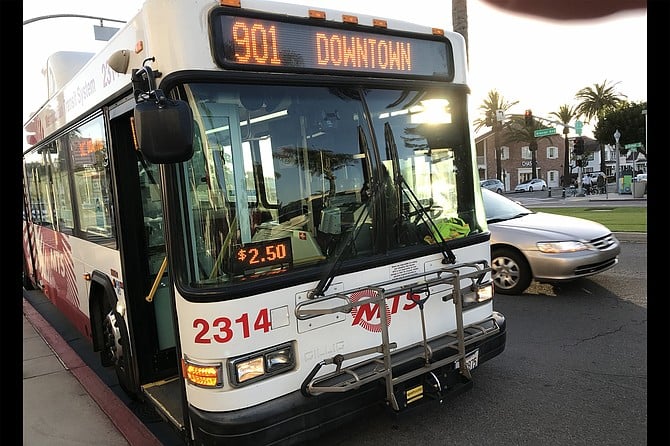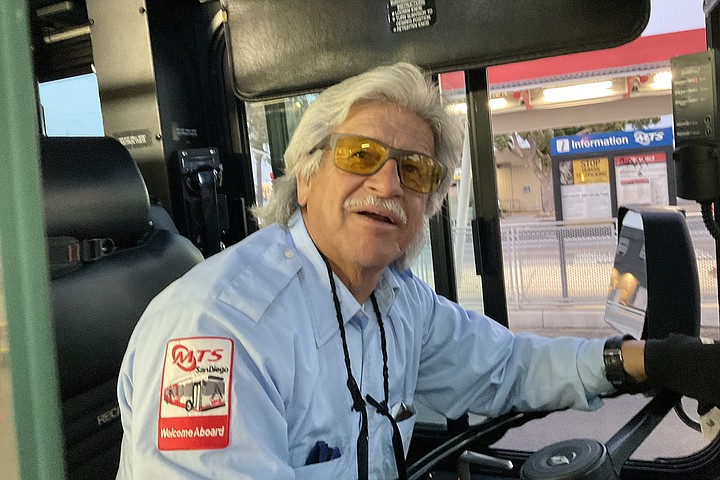 Facebook
Facebook
 X
X
 Instagram
Instagram
 TikTok
TikTok
 Youtube
Youtube

I’m trying to write this aboard the #1 bus. Ha! Judder judder judder judder JUDDER! You have to wonder how these buses hold together. The road surface rides like a bulldozer had grooved the tarmac on a hot day. “This is my worst route for driving, definitely,” Marco the driver tells me. We’re heading down El Cajon Boulevard, the town’s longest street. Bus is pretty empty. It’s nighttime. People on board talk to each other. “I’d lose my partials if I didn’t keep my mouth shut,” the guy next to me says. That gets loud guffaws.
“I’ve been driving this route for ten years,” another driver on another bus, the 120 “Rapid” tells me. “You’ve heard about Street of Dreams? El Cajon Boulevard is the Street of Broken Promises. Just the other day, they told us they had the money to actually start resurfacing the bad patches, and the whole street is one bad patch. Then they lost some lawsuit. And to pay the costs, guess what? They had to plunder this resurfacing fund. Goodbye smooth ECB for another ten years!”

This is a factcheck-free conversation. But maybe confirmation comes from the rattles that make it hard to hear. I mean, it’s not just El Cajon Boulevard. A national non-profit group known as TRIP claims California drivers together lose $61 billion a year because of the punishment that deteriorated roads hand their cars. Some 37 percent of California’s major roads are “deficient,” in poor condition. Only 17 percent of San Diego roads are in good condition.
“I have been on this job over ten years now, and nothing has changed,” says Marco. “We’ve had lots of promises and no action.”
It has always been this way. El Cajon Boulevard used to be Highway 80, the main east-west corridor. This was the way you came into town. And the city has always been behind the 8-ball, trying to catch up with infrastructure as traffic and business and population increased unremittingly.
But now, new promises! “BLVD 2020” is a plan to break the boulevard up into dense, transit-friendly “villages” which give people a sense of place, and hopefully reduce the automobile footprint as people start to work near where they live and discover that transit is the easiest way to get around. We’re told to think of it as part of the “slow” movement, a return to villages, to local, to less hectic. Also, you want diversity? New rules will make sure each development caters to low, medium and high incomes. So no gentrification, no siloing. And to make things interesting, uniquely, the Boulevard already boasts 56 cultures, people who have settled the area who speak 56 languages, represent 56 social entities, and hey, cook 56 cuisines. The enrichment and benefits can power all the communities, as they already do, from Little Saigon to Little Mogadishu to Little Italy to — who knows? — Little Ukraine?
Another side benefit of this plan should be reduced traffic: not just slowing down to smell the roses, but clean air to smell them in through reduced CO2 creation. “We have a once-in-a-generation opportunity to transform El Cajon Boulevard into a zero-carbon, climate friendly corridor,” Nicole Capretz, executive director of the non-profit Climate Action Campaign told the U-T recently.
And just perhaps, as more of us let our laptops do the walking, if this BLVD 2020 plan flies — and many before it have not — ECB could become like a string of pearls, each pearl a “village” along this ancient east-west migration route of the Kumeyaay people.
In the meantime, Marco heads his #1 bus out to rattle down through Balboa Park and into America’s finest city. “Rattles are here for a bit yet,” he says. “May as well get used to it.”


I’m trying to write this aboard the #1 bus. Ha! Judder judder judder judder JUDDER! You have to wonder how these buses hold together. The road surface rides like a bulldozer had grooved the tarmac on a hot day. “This is my worst route for driving, definitely,” Marco the driver tells me. We’re heading down El Cajon Boulevard, the town’s longest street. Bus is pretty empty. It’s nighttime. People on board talk to each other. “I’d lose my partials if I didn’t keep my mouth shut,” the guy next to me says. That gets loud guffaws.
“I’ve been driving this route for ten years,” another driver on another bus, the 120 “Rapid” tells me. “You’ve heard about Street of Dreams? El Cajon Boulevard is the Street of Broken Promises. Just the other day, they told us they had the money to actually start resurfacing the bad patches, and the whole street is one bad patch. Then they lost some lawsuit. And to pay the costs, guess what? They had to plunder this resurfacing fund. Goodbye smooth ECB for another ten years!”

This is a factcheck-free conversation. But maybe confirmation comes from the rattles that make it hard to hear. I mean, it’s not just El Cajon Boulevard. A national non-profit group known as TRIP claims California drivers together lose $61 billion a year because of the punishment that deteriorated roads hand their cars. Some 37 percent of California’s major roads are “deficient,” in poor condition. Only 17 percent of San Diego roads are in good condition.
“I have been on this job over ten years now, and nothing has changed,” says Marco. “We’ve had lots of promises and no action.”
It has always been this way. El Cajon Boulevard used to be Highway 80, the main east-west corridor. This was the way you came into town. And the city has always been behind the 8-ball, trying to catch up with infrastructure as traffic and business and population increased unremittingly.
But now, new promises! “BLVD 2020” is a plan to break the boulevard up into dense, transit-friendly “villages” which give people a sense of place, and hopefully reduce the automobile footprint as people start to work near where they live and discover that transit is the easiest way to get around. We’re told to think of it as part of the “slow” movement, a return to villages, to local, to less hectic. Also, you want diversity? New rules will make sure each development caters to low, medium and high incomes. So no gentrification, no siloing. And to make things interesting, uniquely, the Boulevard already boasts 56 cultures, people who have settled the area who speak 56 languages, represent 56 social entities, and hey, cook 56 cuisines. The enrichment and benefits can power all the communities, as they already do, from Little Saigon to Little Mogadishu to Little Italy to — who knows? — Little Ukraine?
Another side benefit of this plan should be reduced traffic: not just slowing down to smell the roses, but clean air to smell them in through reduced CO2 creation. “We have a once-in-a-generation opportunity to transform El Cajon Boulevard into a zero-carbon, climate friendly corridor,” Nicole Capretz, executive director of the non-profit Climate Action Campaign told the U-T recently.
And just perhaps, as more of us let our laptops do the walking, if this BLVD 2020 plan flies — and many before it have not — ECB could become like a string of pearls, each pearl a “village” along this ancient east-west migration route of the Kumeyaay people.
In the meantime, Marco heads his #1 bus out to rattle down through Balboa Park and into America’s finest city. “Rattles are here for a bit yet,” he says. “May as well get used to it.”
Comments